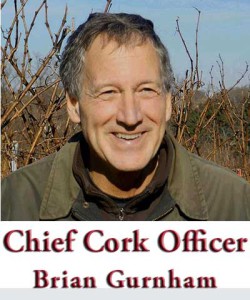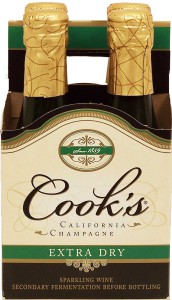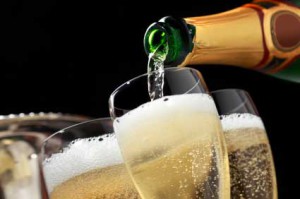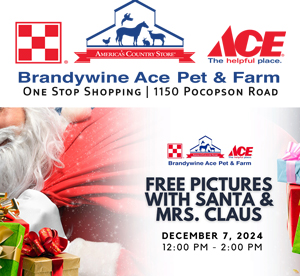When it’s time to ‘pop the bubbly’ here’s what you need to know
By Brian Gurnham, Columnist, The Times
 When I first joined the ranks of the Total Wine team several years ago, I was confused when fellow wine team members began to refer to “sparklers.” Showing signs of my misspent youth, I immediately thought small, hand held pyrotechnic devices had been added to the accessories aisle. I soon learned that a sparkler was a short hand reference to sparkling wines. I have enjoyed many a sparkler in my years of wine tasting, and find this time of year particularly conducive to the festive heritage of the style. If you are thinking about raising a glass or two of sparkling wine for the holidays, here are a few tips that will help you get the maximum enjoyment and value from this century’s old form of libation.
When I first joined the ranks of the Total Wine team several years ago, I was confused when fellow wine team members began to refer to “sparklers.” Showing signs of my misspent youth, I immediately thought small, hand held pyrotechnic devices had been added to the accessories aisle. I soon learned that a sparkler was a short hand reference to sparkling wines. I have enjoyed many a sparkler in my years of wine tasting, and find this time of year particularly conducive to the festive heritage of the style. If you are thinking about raising a glass or two of sparkling wine for the holidays, here are a few tips that will help you get the maximum enjoyment and value from this century’s old form of libation.
 Only buy Champagne if you want Champagne. To be labelled as Champagne, at least under the rules of the European Union, sparkling wine must have been produced in the Appellation Origine Controlee of Champagne, a region in northeast France. Because of the rich history of sparkling wine in this region, and the unique soils and growing conditions (terroir), the French have gone to considerable lengths to preserve and limit the use of the term Champagne.
Only buy Champagne if you want Champagne. To be labelled as Champagne, at least under the rules of the European Union, sparkling wine must have been produced in the Appellation Origine Controlee of Champagne, a region in northeast France. Because of the rich history of sparkling wine in this region, and the unique soils and growing conditions (terroir), the French have gone to considerable lengths to preserve and limit the use of the term Champagne.
However, trademark protection in the United States focusses on producers rather than geographic areas. Because of this, nearly half of the sparkling wine produced in the United States still bears the name of Champagne, although usually clarified as California Champagne or some other term to help differentiate the product from French Champagne. While the debate and trade negotiations continue, the reality is that “true” Champagne is generally regarded as a premier quality product and, because of this, you will pay a premium.
The lowest priced French Champagne is around $30 and vintage year bottles from the likes of Moet and Chandon Dom Perignon reach lofty levels in excess of $2,000, and many a wine purchaser will buy French champagne for the image value. Names like Dom Perignon, Veuve Clicquot, Krug, Taittinger and Bollinger make a statement to the recipient. But if you want to enjoy a delightful sparkling wine, consider a French burgundy made using the same method champenoise, only produced some 100 miles further south. The average price drops to under $20 and the quality remains uniquely French. Further softening of the financial impact can be achieved with Prosecco, an Italian sparkling wine made from the Glera grape, or Cava, a delightful Spanish sparkler made from Macabeo (Viura), Xarel-lo (pr. Sha rel lo), and Parellada. A good Cava can be had for under $10.
 Make sure your sparkler is adequately chilled. Sparkling wines are the category of wine that benefits the most from chilling. Chill your sparkling wine in the refrigerator for a minimum of three to four hours before serving. The best temperature is in the 40 – 45 degrees Fahrenheit range, however many restaurants and party goers will keep their bubbly on ice, reducing temperatures further. If you are in a hurry to chill a bottle you can put it in the freezer, but be careful! Some sparkling wines like Prosecco will have a much lower alcohol content which means that they will quickly form a slushy explosive mix. Fifteen to thirty minutes maximum – and set the timer! Better yet, place the bottle in a bucket of ice water – lots of water to insure contact with the bottle surface. Your wine should be cooled in 20 minutes. It’s better to not over-chill sparkling wine as, much like a still wine, the aromas and taste will begin to wash out, and your expensive investment will begin to taste like carbonated water.
Make sure your sparkler is adequately chilled. Sparkling wines are the category of wine that benefits the most from chilling. Chill your sparkling wine in the refrigerator for a minimum of three to four hours before serving. The best temperature is in the 40 – 45 degrees Fahrenheit range, however many restaurants and party goers will keep their bubbly on ice, reducing temperatures further. If you are in a hurry to chill a bottle you can put it in the freezer, but be careful! Some sparkling wines like Prosecco will have a much lower alcohol content which means that they will quickly form a slushy explosive mix. Fifteen to thirty minutes maximum – and set the timer! Better yet, place the bottle in a bucket of ice water – lots of water to insure contact with the bottle surface. Your wine should be cooled in 20 minutes. It’s better to not over-chill sparkling wine as, much like a still wine, the aromas and taste will begin to wash out, and your expensive investment will begin to taste like carbonated water.
Be Careful opening your sparkler. Sparkling wine by definition contains carbon dioxide gas under pressure – considerable pressure. For the techies out there, 5 atmospheres of pressure, the equivalent of 74 psi, or the pressure in water at a depth of 165 feet. If you have ever removed the cap and let the cork exit on its own power you have an idea of the pressure – fun but also potentially very dangerous if aimed the wrong way.
To open a sparkling wine, remove the foil, and twist the metal key that keeps the wire cage (Muselage) firmly holding the cork. Always keep you hand or a towel over the cork during this process as on more than one occasion I’ve had the little bugger decide that it was time to pop. Grip the bottle with your dominant hand and the cork with the other, using a towel can aid the process and add an element of safety. Slowly begin turning the bottle back and forth with your dominant hand, using your hip or side to steady bottle if you like. You will feel the cork begin to push out – gently allow it to – making sure that the exit is controlled. Aggressively popping the cork is not only dangerous, but usually results in wine effervescing out of the bottle – such a waste. Pour into your finest champagne flutes – yes flutes, not wine glasses or other substitutes. Too much surface area results in bubble loss, and a flat sparkling wine in minutes.
To learn more about the fun world of sparkling wine visit the following articles on CorkQuiz.com.
Champagne “Come quickly ! I’m tasting stars!”
Pinot Meunier – The Secret of Champagne
Sparkling Wines – Home for the Holidays
Enjoy the Holidays and I look forward to seeing you all in the New Year!
Cheers
Brian Gurnham
Chief Cork Officer






